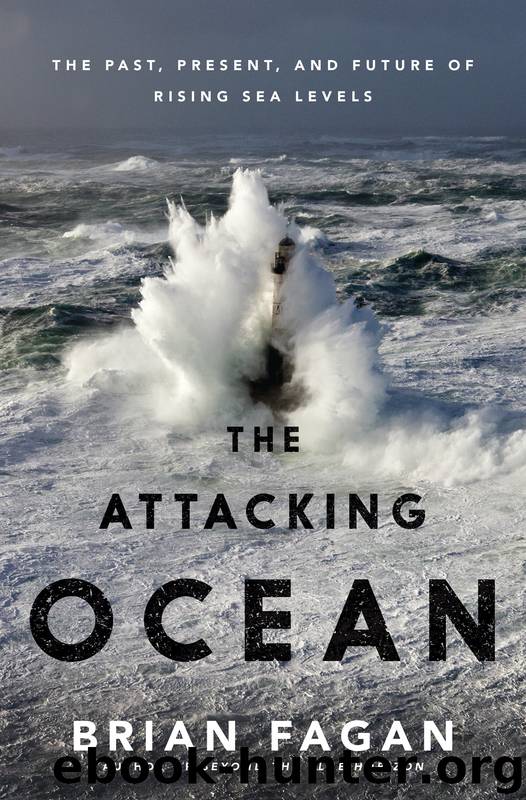The Attacking Ocean by Brian Fagan

Author:Brian Fagan
Language: eng
Format: epub
Tags: The Past, Present, and Future of Rising Sea Levels
Publisher: Bloomsbury Press
Published: 2013-05-10T16:00:00+00:00
LIFE ALONG CHINA’S long, low-lying coastline has involved constant adjustment to changing sea levels ever since the end of the Ice Age. Many people call this a “muddy coast,” a landscape of mudflats and shallow lakes, of wetlands and sand dunes.1 As is the case along all “muddy” coasts with reduced topography, sea level rise can cause extensive horizontal water movement, which is often out of proportion to the actual extent of the rise. Waterlogged environments, often rich in game and plant foods, expand and contract with even minor changes in the ocean. When people lived off game, fish, and plant foods, adapting to these shifts was a simple matter, even when hunting groups lived in the same location for long periods of time. Relationships with the changing sea became more complex when coastal peoples began cultivating rice, today the staff of life for the Chinese.
Rice accounts for over half the food eaten by nearly two billion people and over 21 percent of all calories consumed by humankind. Yet the history of domesticated rice remains largely a mystery, except for the certainty that the Lower Yangtze Valley played a critical role in its early cultivation.2 Unfortunately we have little to go on, except for some charred rice fragments from the walls of a pot found in the delta region dating to around 8000 B.C.E. Much farther upstream, in the Middle Yangtze region, minute rice phytoliths, microscopic fragments of intercellular silica, appear in occupation levels at Diaotonghuan Cave, dating to around 10,000 B.C.E.3
Both these finds were wild forms, for it took five thousand years for fully domesticated rice to develop and become genetically “fixed.” Many generations of early cultivators grew some partially domesticated rice, while still relying on many species of other wild plants, among them fruit and acorns. The crops they planted interbred with wild rice stands, resulting in considerable diversity due to a high rate of genetic exchange. It was not until the nascent farmers created isolated rice plots that fully domesticated forms developed and became fixed.
Download
This site does not store any files on its server. We only index and link to content provided by other sites. Please contact the content providers to delete copyright contents if any and email us, we'll remove relevant links or contents immediately.
The Lonely City by Olivia Laing(4774)
Animal Frequency by Melissa Alvarez(4431)
All Creatures Great and Small by James Herriot(4277)
Walking by Henry David Thoreau(3926)
Exit West by Mohsin Hamid(3797)
Origin Story: A Big History of Everything by David Christian(3666)
COSMOS by Carl Sagan(3593)
How to Read Water: Clues and Patterns from Puddles to the Sea (Natural Navigation) by Tristan Gooley(3434)
Hedgerow by John Wright(3322)
How to Read Nature by Tristan Gooley(3295)
The Inner Life of Animals by Peter Wohlleben(3286)
How to Do Nothing by Jenny Odell(3269)
Project Animal Farm: An Accidental Journey into the Secret World of Farming and the Truth About Our Food by Sonia Faruqi(3194)
Origin Story by David Christian(3170)
Water by Ian Miller(3159)
A Forest Journey by John Perlin(3045)
The Plant Messiah by Carlos Magdalena(2901)
A Wilder Time by William E. Glassley(2838)
Forests: A Very Short Introduction by Jaboury Ghazoul(2815)
